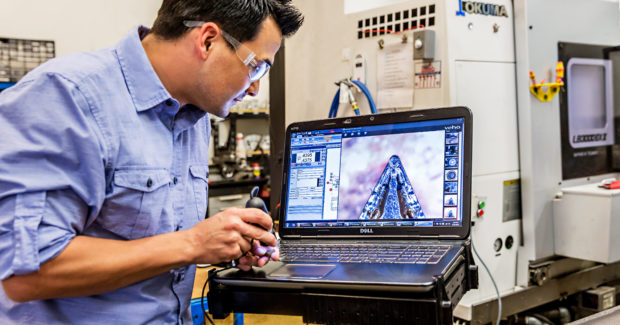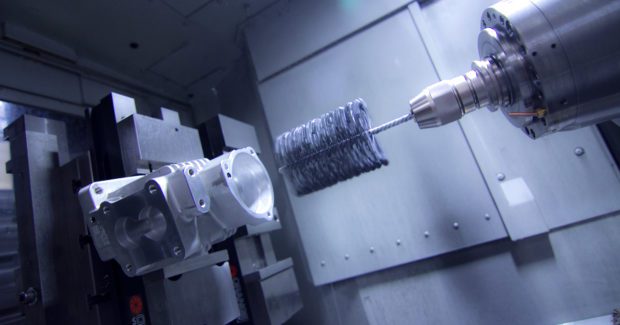Abrasives Are Not All Created Equal
Many shops hesitate to incorporate abrasive finishing tools in CNC machines for fear of clogging coolant lines and damaging slides and bearings. However, finishing tools generate very little grit.
Posted: April 5, 2021
DEPTH OF CUT COLUMN
BY ELYSHA COLE
With advances in abrasive technology, machining center operators are able to complete surface finishing simultaneously with other machining operations, speed cycle times, improve quality and save on off-line finishing time and costs. As a result, contract machine shops are increasingly turning to abrasive finishing tools that can be easily integrated into CNC machines carousels or tool holding systems.
However, in doing so, questions inevitably arise about the use of abrasive materials in expensive CNC machining centers. The concern is often a generalized impression that “abrasives” – like sandpaper – release large amounts of grit and debris that could clog coolant lines or damage exposed slides or bearings.
Q: Can using abrasive materials jeopardize the accuracy or lifespan of CNC machines?
A: These concerns are largely unfounded. Abrasives are often lumped into one category, but a distinction must be made between abrasives used for aggressive material removal and abrasive finishing tools. Finishing tools release little to no abrasive grit, with the amount generated comparable to the metal chips, grinding dust and tool abrasion created during the machining process itself.
Even if minimal fine solids are produced, the filtration requirements for abrasive tools aren’t much different than for machining. Particulate can be easily removed using inexpensive bag or cartridge filtration systems.
Q: What kind of cost is involved for filtration related to the use of abrasive tools?
A: According to Tim Urano, quality manager at Wolfram Manufacturing in Austin, Texas, it’s “not a consideration because filtration systems are already required to remove particulate from the coolant generated during the machining process itself.”
At his shop, that includes scale, grit and rust created by cutting through raw stock. Wolfram Manufacturing is also machining more 3D parts made of Inconel, which can release fine metal powder into the coolant that isn’t fully sintered.
He says Wolfram Manufacturing has never experienced any problems caused by abrasives in cutting fluids.
For the past eight years, the machine shop has incorporated the Flex-Hone in all CNC machines for cross-hole deburring and surface finishing. Removal of burrs and sharp edges in cross-drilled holes and other difficult-to-access areas such as undercuts, grooves, slots, or internal holes is critical. Failing to remove burrs can cause blockages or create turbulence in the flow of fluids, lubricants and gases through critical passages.
“Depending on the number of cross port intersections and different hole sizes, we might deploy two to three different size Flex-Hones on any given part,” Urano says.
They’re added to the tool carousel and are used daily, usually several times an hour, on some of the shop’s highest-volume parts. “The volume of abrasives that could come off is insignificant compared to the rest of the particulate that gets into the coolant.”
Q: Are there other sources of debris in CNC machining?
A: According to Eric Sun, founder of Orange Vise Co. in Placentia, Calif., cutting tools such as carbide drills and end mills can create debris that must be filtered from the coolant.
“Some machine shops might say, ‘I don’t use any abrasives in my process; therefore, my machine is completely free of all particulate matter,’ but that is not the case,” he says. “Cutting tools can wear down and the carbide can come loose and get into the coolant.”
Although Orange Vise is a contract manufacturer, the company primarily machines vises and quick-change fixturing components used in CNC machines out of aluminum, steel and cast iron. The company uses four Mori Seiki NHX4000 high-speed horizontal machining centers and two vertical machining centers.
Many of the vises are made of cast iron with selectively hardened surfaces. To match the surface finish of the hardened surfaces, Orange Vise uses NamPower abrasive disc brushes.
Composed of flexible abrasive nylon filaments bonded to a fiber-reinforced thermoplastic base, the abrasive disc brushes contain a unique combination of ceramic and silicon carbide abrasive. The abrasive filaments work like flexible files, conforming to part contours, wiping and filing across part edges and surfaces to maximize burr removal and enhance surface finish. Other common uses are edge blending, part cleaning, and rust removal.
To complete the surface finishing operation, the brushes are installed in the tool loading system of each CNC machine.
Although abrasive grit is involved, Sun says the brush is a “different type of abrasive” because it is essentially “self-sharpening.” Because of its linear construction, sharp new grains constantly come in contact with the work surface and wear off, exposing fresh cutting particles.
“We’ve used them daily for six years and have had no issues with any sort of particulate or grit getting into any critical surfaces. In our experience, any small amount of grit created is a non-issue.”






